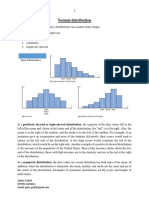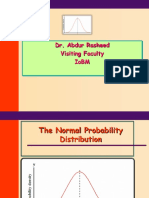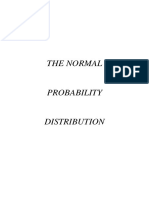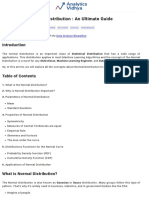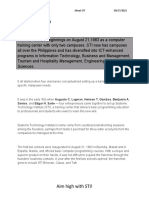0% found this document useful (0 votes)
87 views8 pagesIntroduction To Normal Distribution
Normal distribution is a continuous probability distribution that is symmetric around the mean. It is depicted by a bell-shaped curve and is observed in natural phenomena like heights and test scores. Some key characteristics include that 68% of values fall within one standard deviation of the mean, 95% within two standard deviations, and 99.7% within three. Normal distribution and related concepts like z-scores and the central limit theorem are widely used in applications like quality control, finance, medical research, and hypothesis testing.
Uploaded by
Dipti PandeyCopyright
© © All Rights Reserved
We take content rights seriously. If you suspect this is your content, claim it here.
Available Formats
Download as PPTX, PDF, TXT or read online on Scribd
0% found this document useful (0 votes)
87 views8 pagesIntroduction To Normal Distribution
Normal distribution is a continuous probability distribution that is symmetric around the mean. It is depicted by a bell-shaped curve and is observed in natural phenomena like heights and test scores. Some key characteristics include that 68% of values fall within one standard deviation of the mean, 95% within two standard deviations, and 99.7% within three. Normal distribution and related concepts like z-scores and the central limit theorem are widely used in applications like quality control, finance, medical research, and hypothesis testing.
Uploaded by
Dipti PandeyCopyright
© © All Rights Reserved
We take content rights seriously. If you suspect this is your content, claim it here.
Available Formats
Download as PPTX, PDF, TXT or read online on Scribd
/ 8


























